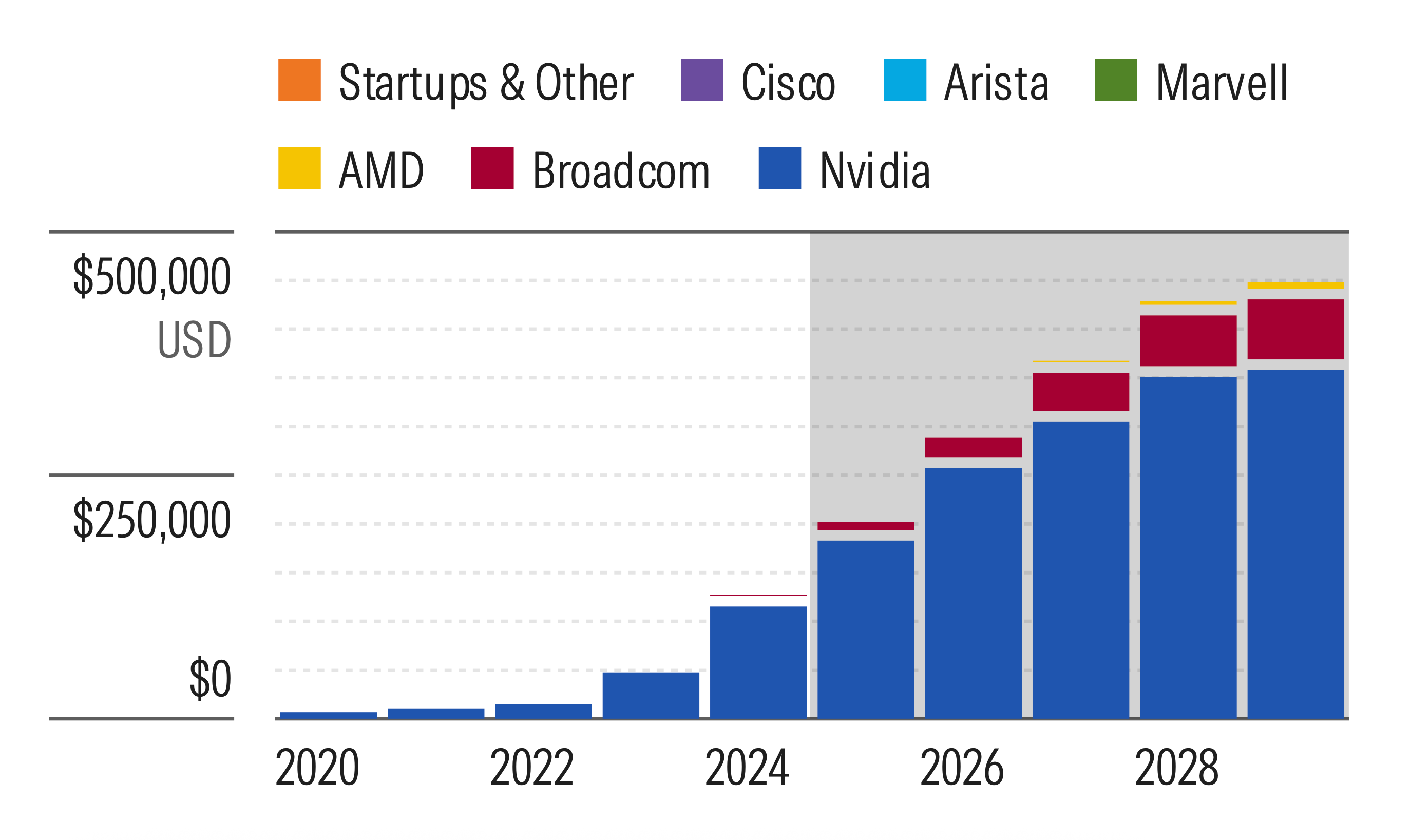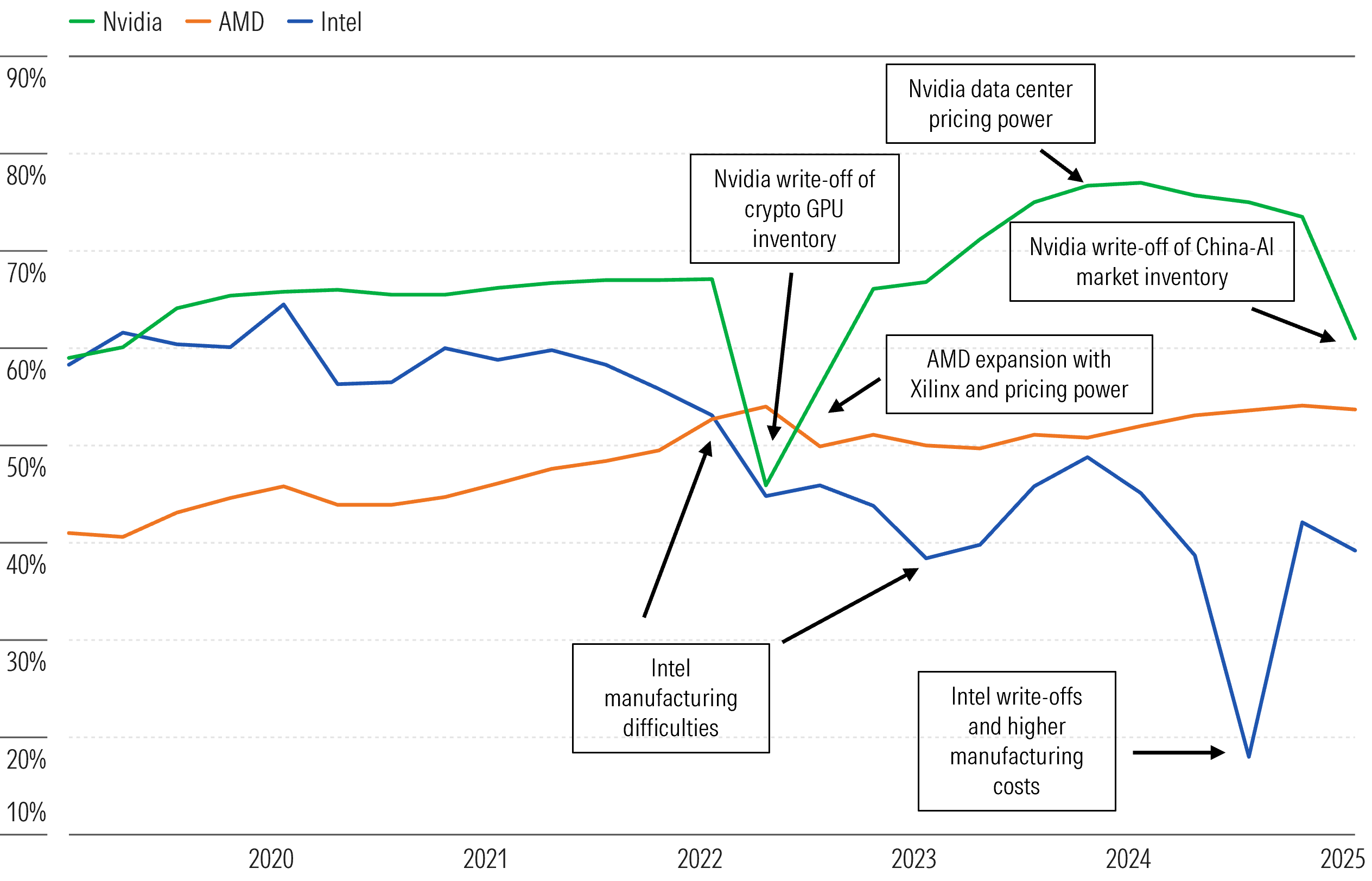5 min read
Generative AI's Rise: Impacts on Networking for Advisors

Ultimately, our optimism around generative AI networking, a critical companion in the hardware that undergirds large language models and image-generating models, remains long-term. Our latest AI Technology Observer report finds that generative AI networking equipment spending is expected to reach $34 billion in 2028, up from our estimate of an $8 billion market in 2023.
Marvell MRVL is our top pick to play the generative AI networking trend, though we see robust future growth adequately priced into the stocks of Arista ANET, Broadcom AVGO, and Nvidia. Investors should look to these stocks as ways to invest in rising generative AI networking spending—Morningstar rates all four as moaty and high-quality.
How AI is Reshaping the Semiconductor Industry Landscape
Over the next several years, AI is expected to be the key growth driver across the broad market. In fact, our recent report on semiconductor industry trends reveals AI accelerator (for example, chip) revenue will increase roughly four times in this time frame.
Nvidia, an industry leader, has been a key contributor to this growth with AI already the company’s primary valuation driver. However, Broadcom is a strong second player with its custom accelerators and AMD comes in third position—though second to Nvidia in general-purpose AI accelerators. For many of these AI chip leaders, we expect AI accelerators to become a primary growth driver.
We anticipate AI to be nearly 40%-50% of total company revenue for other firms including Broadcom, AMD, and Marvell Technology.

Artificial intelligence is a generational demand driver.
AI growth will be more than just Nvidia
We expect fabless designers, fabs, EDA software, IP, and equipment firms to all experience outsize growth, driven largely by AI demand. These include fabs like Taiwan Semiconductor Manufacturing Company (TSMC), software design and IP firms like Cadence, Synopsys, and ARM, and equipment providers like ASM and ASML.
AI is also predicted to benefit networking firms (chips and ethernet connections) and memory firms (high-bandwidth memory). We expect double-digit growth for revenue of pure-play foundries under our coverage over the next five years.
This trend is primarily led by TSMC—the foundry’s revenue is projected to grow consistently, reaching approximately $250 billion by 2029. There are other parts of the value chain that will benefit beyond processing chips—we see material growth coming for networking firms (chips and ethernet connections), memory firms (high-bandwidth memory), and equipment firms and foundries (rising complexity).
Capital spending on AI continues to be strong in 2025, though we expect this momentum to slow in 2026 as macroeconomic risks intensify. Major cloud service providers still plan to increase AI-related capital expenditures by 35% to 40% this year, but early signs point to more cautious investment next year.
In the Q2 Semiconductor Manufacturing Pulse, we identify Taiwan Semiconductor Manufacturing Co. TSM as a dominant force in the chip industry, particularly as a primary beneficiary of AI-related demand.
The firm maintains a strong competitive edge through its cutting-edge technology and premium pricing power factors that support its superior gross margins even during industry downturns. We highlight TSMC as a top investment pick among semiconductor manufacturers because of its broad AI exposure, resilient operations, and ability to outperform peers amid macroeconomic and tariff-related uncertainties.

Nvidia’s gross margins are best of breed, pointing to significant AI pricing power and a wide economic moat.
AI in Cybersecurity
When it comes to the cybersecurity landscape, AI will be a new demand driver as attacks become more sophisticated.
Although the AI security market is small right now, we expect rapid growth as the use of applications proliferates. And for good reason—our recent cybersecurity report suggests that the cost of a data breach is almost 50% higher for companies not using AI security compared with those that leverage these tools.
Given that roughly 10% to 12% of public cloud spending is geared toward security solutions, we forecast the public cloud spending catalyzed by AI will add another $15 billion to $18 billion in security spending.

We size the AI security opportunity at $15 billion-$18 billion by 2028, increasing the estimated market size by over 5%.
A Look at the Generative AI Networking Landscape
Artificial intelligence is transforming the world of investing. To find opportunities and stand out from the competition, financial advisors need to stay informed on the evolving industry.
When you have a deeper understanding of how to invest in AI, it can be easier to identify the right AI stocks and improve your business. Here are key insights to consider.

Source: Morningstar, Inc. Data as of July 15, 2025.


